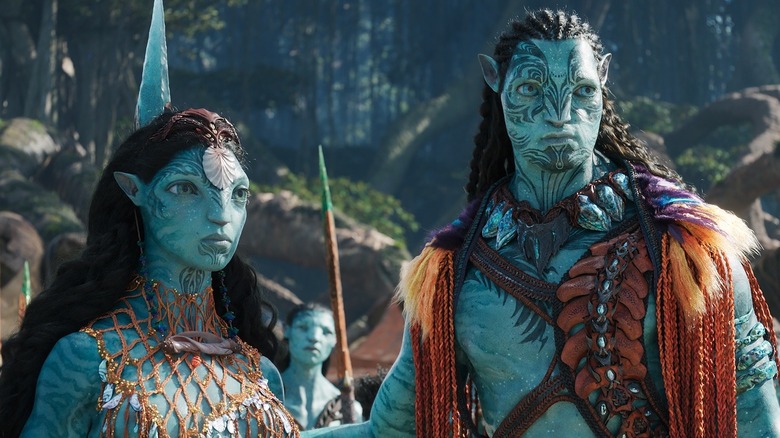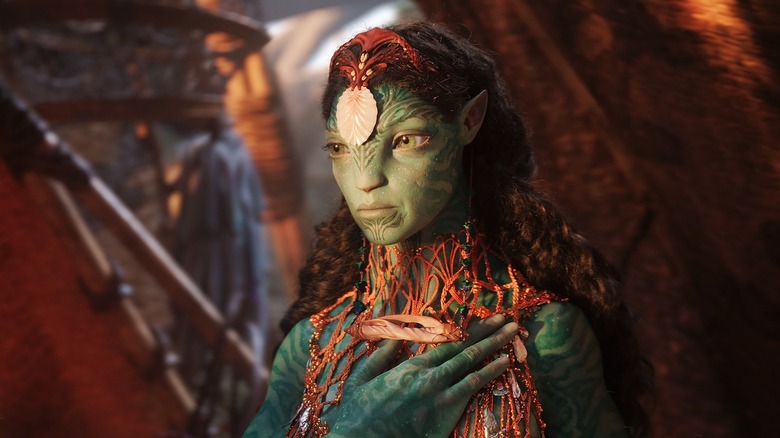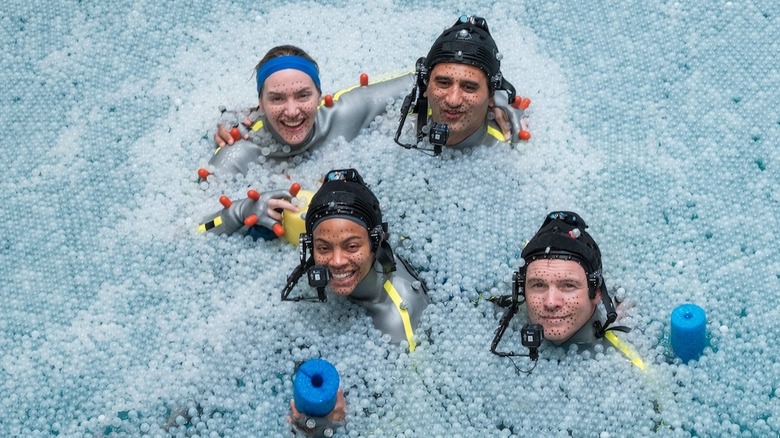How Indigenous Cultures Inspired Avatar: The Way Of Water's Metkayina
The following post contains spoilers for "Avatar: The Way of Water."
After waiting 13 years, James Cameron's sequel "Avatar: The Way of Water" has hit theaters. The film continues the story of Jake Sully (Sam Worthington), a military man on the moon of Pandora whose consciousness has been put into the body of a native Na'vi. Since the last film, Sully has married and started a family with Neytiri (Zoe Saldaña) and raised their biological children with several others that have become part of their lives.
The humans who were once mining unobtanium on Pandora left after the events of "Avatar," minus a few sympathetic scientists. Now, years later, they've returned for even more nefarious purposes. They're also hunting down Sully and his family. To keep their people safe, the Sully family must flee from the forest where they've been living to the Metkayina, the oceanic Na'vi people, who are led by Tonowari (Cliff Curtis) and Ronal (Kate Winslet).
The Metkayina live and hunt in and around the water, and have evolved different physical attributes such as fin-like arms and thicker tails for swimming. Though these people have the same ancestors, their cultures are vastly different.
In an interview with National Geographic, director James Cameron spoke about the film and how the Metkayina were inspired by several Indigenous cultures around the world.
A regional, Indigenous culture
James Cameron's love affair with the ocean is well-known. He's done dives down to the Titanic site and the first solo dive to the bottom of the Mariana Trench in the "Deepsea Challenger" expedition. He is also the executive producer of National Geographic's "Secrets of the Whales." He and his team created many underwater creatures like the sentient and poetically-minded Tulkun, a sort of whale analog who psychically partner with some of the Metkayina. Cameron says:
"The Metkayina are a kind of a regional, Indigenous culture: They diverged from the land-based forest Na'vi [of the first film] probably tens of thousands of years ago and have physically adapted more to the ocean. Their tails are actually used for propulsion as in the way that they swim, like seals and otters. They're air-breathers, so they've adapted to being able to hold their breath for long periods of time. They have nictitating membranes, kind of like crocodiles and owls, to protect their eyes when they're entering the water at high speed as they're riding [ilu], these creatures that they've tamed and have this symbiotic relationship with."
The differences between the Na'vi and the Metkayina are a plot point in the film, with the Indigenous children teasing the Sully children about their thin tails. Cameron also mentions that the Tulkun rely on the Metkayina for anything that involves hands and technology.
Put it through the lens of Pandora
The director wanted to create a culture around Pandora's ocean that had a foundation in our own world's Indigenous peoples — specifically the Polynesian and Sama-Bajau people of Indonesia, and the Maori people of New Zealand.
Cameron explains to the publication:
"We did a lot of research about real Indigenous cultures that are very tightly associated with the ocean. We looked at Polynesian culture, which is a canoe trading culture. We decided not to do canoes other than some canoes that are used locally. The voyaging in our film—I can't speak to future films—is not the [Polynesian] voyaging culture that uses the big canoes, or waka as they call them here in New Zealand.
"It was like, how do we take Indigenous culture here on our planet and put it through the lens of Pandora? There are [the Sama-Bajau], people in Indonesia who live on stilted homes and live on rafts. We looked at things like that."
In "The Way of Water," we certainly see the stilted homes. It will be interesting to see what sort of voyaging happens and the boats they use in the third film with a hint like that. In this film, much of the traveling seems to be done while swimming with creatures, requiring the ability to hold one's breath for a long time during free diving, something Kate Winslet and Sigourney Weaver, who plays the teenager Kiri, learned to do for an incredible span.
"Avatar: The Way of Water" is currently in theaters.


